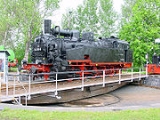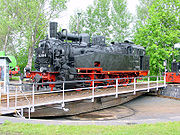
Saxon XI HT
Encyclopedia
| Saxon XI HT DRG 94.19-21 ÖBB Class 794 |
|||
|---|---|---|---|
 |
|||
| Manufacturer | Sächsische Maschinenfabrik Sächsische Maschinenfabrik The Sächsische Maschinenfabrik in Chemnitz was one of the most important engineering companies in Saxony in the second half of the 19th century and the first two decades of the 20th century. Including its various predecessor businesses, the firm existed from 1837 until its liquidation in 1930, and... , Chemnitz Chemnitz Chemnitz is the third-largest city of the Free State of Saxony, Germany. Chemnitz is an independent city which is not part of any county and seat of the government region Direktionsbezirk Chemnitz. Located in the northern foothills of the Ore Mountains, it is a part of the Saxon triangle... |
||
| Quantity | 10 | 17 | 136 |
| Numbering | 2019–2028 94 1901–1908 |
2001–2018 94 2001–2017 |
2029–2154 94 2018–2139 94 2151–2152 |
| Entered service: | 1910 | 1908–1909 | 1915–1923 |
| Retired: | by 1936 | by 1975 | |
| Wheel arrangement Whyte notation The Whyte notation for classifying steam locomotives by wheel arrangement was devised by Frederick Methvan Whyte and came into use in the early twentieth century encouraged by an editorial in American Engineer and Railroad Journal... : |
0-10-0T | ||
| Axle arrangement UIC classification The UIC classification of locomotive axle arrangements describes the wheel arrangement of locomotives, multiple units and trams. It is set out in the International Union of Railways "Leaflet 650 - Standard designation of axle arrangement on locomotives and multiple-unit sets". It is used in much... : |
E h2t | ||
| Type: | Gt 55.15 | Gt 55.16 | Gt 55.16 |
| Rail gauge Rail gauge Track gauge or rail gauge is the distance between the inner sides of the heads of the two load bearing rails that make up a single railway line. Sixty percent of the world's railways use a standard gauge of . Wider gauges are called broad gauge; smaller gauges, narrow gauge. Break-of-gauge refers... : |
1,435 mm | ||
| Length over buffers Buffer (rail transport) A buffer is a part of the buffers-and-chain coupling system used on the railway systems of many countries, among them most of those in Europe, for attaching railway vehicles to one another.... : |
12.080 mm | 12,200 mm | 12,390 mm 12,560 mm (from 2034) |
| Service weight: | 74.1 t | 77.3 t | 79.4 t |
| Adhesive weight Adhesive weight Adhesive weight is the amount of a locomotive's weight that is applied to the driving wheels and so capable of delivering traction. The more weight applied to the driving wheels, the greater the locomotive's ability to haul a load. But if the weight on the driving wheels exceeds the axle load of... : |
74.1 t | 77.3 t | 79.4 t |
| Axle load Axle load The axle load of a wheeled vehicle is the total weight felt by the roadway for all wheels connected to a given axle. Viewed another way, it is the fraction of total vehicle weight resting on a given axle... : |
14.82 t | 15.46 t | 15.88 t |
| Driving wheel Driving wheel On a steam locomotive, a driving wheel is a powered wheel which is driven by the locomotive's pistons... diameter: |
1,260 mm | ||
| Top speed: | 45 km/h | 45 km/h | 60 km/h |
| Indicated power: | n.k. | ||
| Piston stroke: | 630 mm | ||
| Cylinder bore | 590 mm | 620 mm | 620 mm |
| Boiler Boiler A boiler is a closed vessel in which water or other fluid is heated. The heated or vaporized fluid exits the boiler for use in various processes or heating applications.-Materials:... overpressure Overpressure The term Overpressure is applied to a pressure difference, relative to a "normal" or "ambient" pressure, in various circumstances:* In engineering: the pressure difference over the wall thickness of a pressure vessel... : |
12 bar | ||
| Grate area: | 2,0 m² | 2,27 m² | 2,30 m² |
| Evaporative heating area: | 124,69 m² | 136,34 m² | 136,55 m² |
| Superheater Superheater A superheater is a device used to convert saturated steam or wet steam into dry steam used for power generation or processes. There are three types of superheaters namely: radiant, convection, and separately fired... area: |
36,7 m² | 41,4 m² | 41,4 m² |
| Brakes: | Steam brake Later fitted with Westinghouse Westinghouse Air Brake Company The railway air brake was invented by George Westinghouse of New York state in 1869. Soon after, he moved to Pittsburgh, Pennsylvania, where he established the Westinghouse Air Brake Company on September 28, 1869... compressed-air brake some with Riggenbach Riggenbach Riggenbach can refer to:*Albert Riggenbach, meteorologist*Niklaus Riggenbach, inventor*Riggenbach counter-pressure brake*Riggenbach rack system*Holly Black née Riggenbach*Riggenbach's gerbil... counterpressure brake |
||
The Saxon Class XI
 T were German, ten-coupled, tank locomotives with the Royal Saxon State Railways
T were German, ten-coupled, tank locomotives with the Royal Saxon State RailwaysRoyal Saxon State Railways
The Royal Saxon State Railways were the state-owned railways operating in the Kingdom of Saxony from 1869 to 1918...
procured for goods train services. The Deutsche Reichsbahn
Deutsche Reichsbahn
Deutsche Reichsbahn was the name of the following two companies:* Deutsche Reichsbahn, the German Imperial Railways during the Weimar Republic, the Third Reich and the immediate aftermath...
grouped them in 1925 into their DRG Class 94.19-21.
History
As a consequence of the reparationsWorld War I reparations
World War I reparations refers to the payments and transfers of property and equipment that Germany was forced to make under the Treaty of Versailles following its defeat during World War I...
required to be paid by Germany
Germany
Germany , officially the Federal Republic of Germany , is a federal parliamentary republic in Europe. The country consists of 16 states while the capital and largest city is Berlin. Germany covers an area of 357,021 km2 and has a largely temperate seasonal climate...
after the First World War, 12 locomotives went to the French state railway, ETAT, and one to the French Northern Railway; a further 3 engines had been lost during the course of the war.
The Deutsche Reichsbahn grouped the lighter engines of the second batch into its DRG Class 94.19, whilst the heavier ones were designated as DRG Class 94.20-21. The engines of the lighter group were retired by 1936.
All those engines left in Germany
Germany
Germany , officially the Federal Republic of Germany , is a federal parliamentary republic in Europe. The country consists of 16 states while the capital and largest city is Berlin. Germany covers an area of 357,021 km2 and has a largely temperate seasonal climate...
after the Second World War went into the Deutsche Reichsbahn in East Germany. The DR also received two engines from abroad and grouped them as numbers 94 2151 and 94 2152. The last ones were in service until the second half of the 1970s.
The non-working locomotive, 94 2110, ended up after the war in Austria
Austria
Austria , officially the Republic of Austria , is a landlocked country of roughly 8.4 million people in Central Europe. It is bordered by the Czech Republic and Germany to the north, Slovakia and Hungary to the east, Slovenia and Italy to the south, and Switzerland and Liechtenstein to the...
after passing through Czechoslovakia
Czechoslovakia
Czechoslovakia or Czecho-Slovakia was a sovereign state in Central Europe which existed from October 1918, when it declared its independence from the Austro-Hungarian Empire, until 1992...
and Hungary
Hungary
Hungary , officially the Republic of Hungary , is a landlocked country in Central Europe. It is situated in the Carpathian Basin and is bordered by Slovakia to the north, Ukraine and Romania to the east, Serbia and Croatia to the south, Slovenia to the southwest and Austria to the west. The...
. It was incorporated into the fleet of the Austrian Federal Railway as ÖBB 794.2110, but was retired in 1953 without having been used.
Of the locomotives remaining in Czechoslovakia after the war, several continued to be used for a time. Locomotive 94 2021 was even given the ČSD
CSD
CSD may refer to:*Cali Swag District*California School for the Deaf*Cambridge Structural Database*Canonical signed digit*Canteen Stores Department *Canteen Stores Department *Carbonated Soft Drink*Cat scratch disease...
number 516.0500 and was not retired until 1952.
The last area of operations for these locomotives in the Deutsche Reichsbahn
Deutsche Reichsbahn
Deutsche Reichsbahn was the name of the following two companies:* Deutsche Reichsbahn, the German Imperial Railways during the Weimar Republic, the Third Reich and the immediate aftermath...
was on the ramp from Eibenstock
Eibenstock
Eibenstock is a town in the western Ore Mountains, in the Erzgebirgskreis, Saxony, Germany. It is situated near the river Mulde.- Geography :...
upper station to Eibenstock lower station which was closed in autumn 1975.
The last preserved locomotive of this class - number 94 2105 - may be found today in the railway museum at Schwarzenberg/Erzgeb..
Technical features
The engines of the second batch had a lower weight, due to their shorter boilerBoiler
A boiler is a closed vessel in which water or other fluid is heated. The heated or vaporized fluid exits the boiler for use in various processes or heating applications.-Materials:...
and a reduction in the coal and water capacity, in order to be able to run on branch lines with light trackway.
From running number 2094 (1921 series) onwards the locomotives had factory-fitted compressed-air brakes, from running number 2112 (1923 series) the engines were equipped with Knorr feedwater heater
Feedwater heater
A feedwater heater is a power plant component used to pre-heat water delivered to a steam generating boiler. Preheating the feedwater reduces the irreversibilities involved in steam generation and therefore improves the thermodynamic efficiency of the system...
s on the crown of the boiler barrel behind the chimney. Those engines delivered prior to that were all retrofitted with compressed-air brakes and, in most cases, also with surface economisers. The 1908/09 series only rarely had preheaters. Where they were fitted they were located to the side of the chimney.
Sources
- Günther Reiche: 'Richard Hartmann und seine Lokomotiven Oberbaumverlag Berlin/Chemnitz 1998 ISBN 3-928254-56-1
See also
- Royal Saxon State RailwaysRoyal Saxon State RailwaysThe Royal Saxon State Railways were the state-owned railways operating in the Kingdom of Saxony from 1869 to 1918...
- List of Saxon locomotives and railbuses

